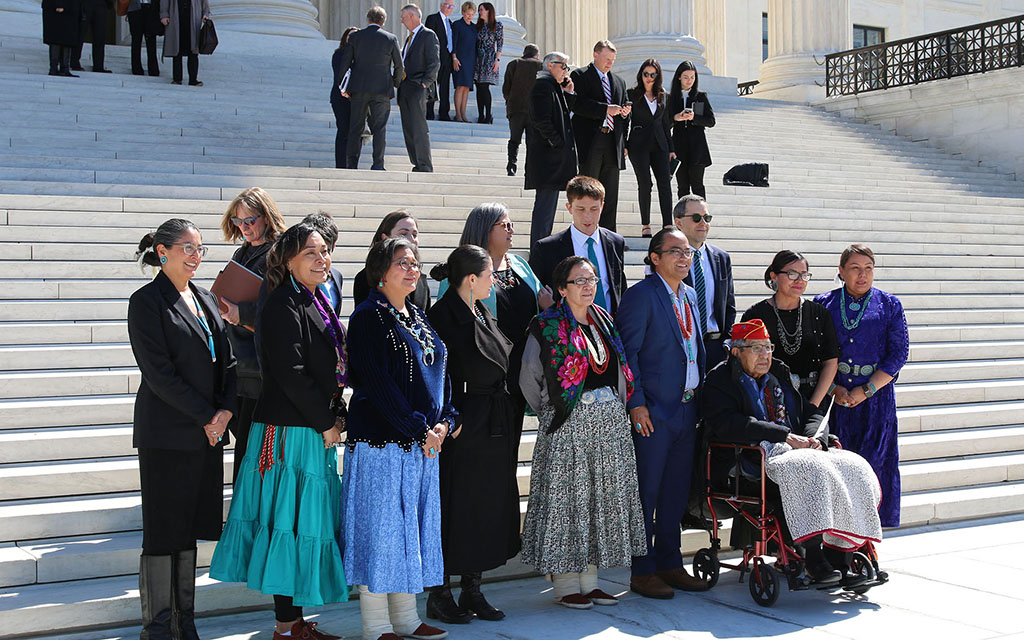
Despite having rights to Gila River water, the Gila River Indian Community also has to get water from the Central Arizona Project through canals. But the tribe recently announced that it will forgo 125,000 acre feet of Lake Mead water, earning it millions in federal funding aimed at encouraging water conservation. (Photo by Ted Wood/The Water Desk)
The Gila River Indian Community could get up to $233 million in federal funding for water conservation, one of the first to get the money under a program aimed at encouraging water cutbacks in Arizona, California and Nevada.
The tribe will get $50 million from the Inflation Reduction Act this year in exchange for agreeing to leave 125,000 acre feet of water in Lake Mead that it would otherwise be entitled to. There is an option for the tribe to do so again in 2024 and 2025, receiving $50 million for each year it conserves that much water in the lake, which is at dangerously low levels.
The tribe will get another $83 million from the Bipartisan Infrastructure Law to expand water reuse efforts. It will fund a reclaimed water pipeline that, when completed, will add up to 20,000 acre-feet annually for system conservation, with a minimum of 78,000 acre-feet committed to remain Lake Mead.
“We want to be good actors,” said Gila River Indian Community Gov. Stephen Roe Lewis in October, when the tribe first announced its intent to conserve water. “We want to make sure that the precious water supplies we have, that it’s going to go to a sustainable solution.”
The federal payments to the tribe break down to $400 per acre-foot of water. An acre-foot is the amount of water needed to fill one acre of land to a depth of one foot. One acre-foot generally provides enough water for one to two households for a year.
Sarah Porter, director of the Kyl Center for Water Policy at Arizona State University, cautioned that funding sent to the Gila River Indian Community does not necessarily indicate that the federal water conservation program is working at a broader level.
“It doesn’t say as much as we might hope, because this program is competing with current commodity prices,” Porter said.
“I have asked a few growers who have the opportunity to participate if they will, and it’s clear that the high price of different agricultural commodities is getting in the way,” she said. “The Gila River Indian community is in a unique position to participate.”
Porter said this abnormally wet winter will give a short-term boost to reserves throughout the Southwest. While that has removed some of the “moral imperative” to conserve water, she said more cutbacks are still needed to help Lake Mead.
The actions come as water has fallen to historically low levels at Lake Mead, the nation’s largest reservoir, as the region struggles through a decades-long drought. The dropping lake levels could threaten the Hoover Dam’s ability to generate hydropower and are raising concerns about the reservoir’s long-term ability to provide water to millions of people in cities such as Phoenix, Las Vegas and Los Angeles.
More than a century of laws and lawsuits govern the allocation of water from the Colorado River to states in the region and between the U.S. and Mexico. States include the Lower Colorado Basin states of Arizona, California and Nevada and the Upper Colorado Basin states of New Mexico, Utah, Coloardo and Wyoming. Besides generating power for millions, the river is critical to agriculture in the region and provides water to as many as 40 million people in the West.

Water levels in Lake Mead sit low near Hoover Dam in this photo from December 2021. State and federal officials are scrambling for solutions, as ongoing drought in the Southwest has sent reservoirs to historically low levels. (Photo by Alex Hager/KUNC)
Current guidelines for the Colorado River are set to expire in 2026, and states are expected to negotiate a new set of rules for how water from the basin is shared. As climate change shrinks supplies, state and federal governments have assembled a patchwork of short-term conservation agreements to chip away at demand and prevent catastrophe before then.
The Gila River Indian Community is one of 30 federally recognized tribes in seven states that draw water from the Colorado River, and it is among the most prominent tribal voices in the regional conversations about water use.
The 30 tribes that use the Colorado River hold rights to about a quarter of its flow, but have often been excluded from negotiations about how the river’s water is used. At the same time, tribal communities often lack reliable access to clean water due to aging infrastructure and a history of underinvestment.
Tribes are calling for greater inclusion as the basin prepares for pre-2026 negotiations. Last August, The Gila River Indian Community was among the 14 tribes that signed a letter saying they had been left “in the dark” during midsummer conservation talks.
– This story is part of ongoing coverage of the Colorado River, produced by KUNC and supported by the Walton Family Foundation.
